Diagnostic Study of a Severe Dust Storm over North Africa and the Arabian Peninsula
Abstract
:1. Introduction
2. Data and Methodology
2.1. Data
2.2. Theoretical Considerations
2.2.1. The Simple Form of the Vorticity Equation
2.2.2. The Horizontal Advection of Temperature Form
2.2.3. The Isallobaric Wind
2.2.4. The Frontogenetical Function
2.2.5. The Rotational and Divergent Winds
2.3. Analytical Procedures
3. Results and Discussion
3.1. Synoptic Analysis and Discussion
3.2. Analysis of Isobaric Vorticity
3.3. Horizontal Distribution of Cooling/Heating and Vertical Motion
3.4. The Role of the Low-Level Wind on Cyclone Development
3.5. Meridional Temperature Gradient Analysis
3.6. Frontogenesis
3.7. Spatiotemporal Evolution of Dust Emission
4. Remarks on the Cyclogenesis Mechanism of This Case
- (1)
- A disturbance in the high troposphere and an enhancement in baroclinicity are the initial synoptic conditions.
- (2)
- The jet stream region is the primary source of kinetic energy imported into the cyclone zone.
- (3)
- When a low-level region of warm advection (or near absence of cold advection) is covered by an already existing upper trough with significant vorticity advection on its forward side, development begins.
- (4)
- The distance between the upper trough and the low-level system rapidly narrows.
- (5)
- Thermal advection is initially small but grows as the low-level cyclone intensifies.
- (6)
- The amount of vorticity advection aloft is significant initially and gets smaller as peak intensity approaches.
- (7)
- Lower troposphere baroclinicity is comparatively low and rises as the storm gets stronger.
- (8)
- Both a front and several fronts co-occurring cannot be identified in the domain of the cyclone.
- (9)
- At first, the disturbance moves rather quickly, but as the cyclone gets closer to its maximum intensity, it moves less quickly.
- (10)
- As the storm nears its peak intensity, the cut-off is routinely seen.
5. Conclusions
- A significant trough at 850 hPa with a strong north–south orientation allowed cold air to enter northern Africa (Algeria) from higher latitudes. The desert cyclone formed over Algeria when the contrast of temperature between North Africa (the Sahara) and the Mediterranean Sea (the water) was intense due to the significant increase in temperatures over the hot Sahara compared to the cold seawater. Our desert cyclone developed along the front, where the cold air from the Mediterranean Sea met the hot air from Africa.
- The cyclone and its front were the main dynamic elements that mobilized and transported dust through the life cycle of this cyclone. Powerful winds (≥25 m/s) at the surface connected with the cyclone cold front caused significant dust emissions as it passed across Algeria, Libya, Mali, and Egypt. After the dust production at a high altitude (~3 km), upward mixing around the cyclone eye occurred. In addition to transporting air masses of dust, the cyclone continued to generate dust locally as it moved over the hot desert.
- The analysis of vorticity in isobaric coordinates is a practical, precise, and simple technique to describe the initiation and evolution of our case of cyclogenesis. Additionally, the presentation of the chronology of the relative vorticity on different isobaric surfaces has helped to understand the dynamics of low-level evolution easily.
- The LLJ forms when a desert cyclone (baroclinic wave) develops over northern Africa, usually in the lee of the Atlas Mountains, and the meridional gradient of temperature strengthens. The convergence at a lower level is offset by divergence in the upper troposphere (700 hPa in this case), and this is evident by the divergence cycle associated with this baroclinic wave. The intense vertical motion brought on by the lower-tropospheric convergence sustains the dust emission produced by severe storms over the surface just northeast of the low-level jet.
- The study indicated the role of some mechanisms in frequently occurring desert depressions in North Africa, including the lee effects of the mountains, strong boundary layer baroclinity (since the northern African coast has a significant meridional temperature gradient), and low-level jet stream related to the circulations.
- The overall amount of dust noticed each year across North and East Africa may be considerably impacted by desert cyclones of this type. High dust loads related to this type of cyclone throughout its life and along its path are also anticipated to influence the regional energy budget and radiate over northern and eastern Africa, and it may also influence the atmospheric dynamics in that area.
Author Contributions
Funding
Institutional Review Board Statement
Informed Consent Statement
Data Availability Statement
Acknowledgments
Conflicts of Interest
References
- Prospero, J.M.; Ginoux, P.; Torres, O.; Nicholson, S.E.; Gill, T.E. Environmental characterization of global sources of atmospheric soil dust identified with the Nimbus 7 Total Ozone Mapping Spectrometer (TOMS) absorbing aerosol product. Rev. Geo-Phys. 2002, 40, 2-1-2-31. [Google Scholar] [CrossRef]
- Engelstaedter, S.; Tegen, I.; Washington, R. North African dust emissions and transport. Earth-Sci. Rev. 2006, 79, 73–100. [Google Scholar] [CrossRef]
- Laurent, B.; Marticorena, B.; Bergametti, G.; Léon, J.F.; Mahowald, N.M. Modeling mineral dust emissions from the Sahara desert using new surface properties and soil database. J. Geophys. Res. Atmos. 2008, 113, D14218. [Google Scholar] [CrossRef] [Green Version]
- Gerasopoulos, E.; Kouvarakis, G.; Babasakalis, P.; Vrekoussis, M.; Putaud, J.; Mihalopoulos, N. Origin and variability of particulate matter (PM10) mass concentrations over the Eastern Mediterranean. Atmos. Environ. 2006, 40, 4679–4690. [Google Scholar] [CrossRef]
- Balis, D.; Amiridis, V.; Kazadzis, S.; Papayannis, A.; Tsaknakis, G.; Tzortzakis, S.; Kalivitis, N.; Vrekoussis, M.; Kanakidou, M.; Mihalopoulos, N.; et al. Optical characteristics of desert dust over the East Mediterranean during summer: A case study. Ann. Geophys. 2006, 24, 807–821. [Google Scholar] [CrossRef] [Green Version]
- Kalivitis, N.; Gerasopoulos, E.; Vrekoussis, M.; Kouvarakis, G.; Kubilay, N.; Hatzianastassiou, N.; Vardavas, I.; Mihalopoulos, N. Dust transport over the eastern Mediterranean derived from Total Ozone Mapping Spectrometer, Aerosol Robotic Network, and surface measurements. J. Geophys. Res. 2007, 112, D03202. [Google Scholar] [CrossRef] [Green Version]
- Amiridis, V.; Kafatos, M.; Perez, C.; Kazadzis, S.; Gerasopoulos, E.; Mamouri, R.E.; Papayannis, A.; Kokkalis, P.; Giannakaki, E.; Basart, S.; et al. The potential of the synergistic use of passive and active remote sensing measurements for the validation of a regional dust model. Ann. Geophys. 2009, 27, 3155–3164. [Google Scholar] [CrossRef] [Green Version]
- Derbyshire, E. Natural Minerogenic Dust and Human Health. AMBIO J. Hum. Environ. 2007, 36, 73–77. [Google Scholar] [CrossRef]
- Mitsakou, C.; Kallos, G.; Papantoniou, N.; Spyrou, C.; Solomos, S.; Astitha, M.; Housiadas, C. Saharan dust levels in Greece and received inhalation doses. Atmos. Chem. Phys. 2008, 8, 7181–7192. [Google Scholar] [CrossRef] [Green Version]
- Nastos, P.T.; Paliatsos, A.G.; Anthracopoulos, M.B.; Roma, E.S.; Priftis, K.N. Outdoor particulate matter and childhood asthma admissions in Athens, Greece: A time-series study. Environ. Health 2010, 9, 45. [Google Scholar] [CrossRef]
- Samoli, E.; Nastos, P.T.; Paliatsos, A.G.; Katsouyanni, K.; Priftis, K.N. Acute effects of air pollution on pediatric asthma exacerbation: Evidence of association and effect modification. Environ. Res. 2011, 111, 418–424. [Google Scholar] [CrossRef] [PubMed]
- Solomos, S.; Kallos, G.; Kushta, J.; Astitha, M.; Tremback, C.; Nenes, A.; Levin, Z. An integrated modeling study on the effects of mineral dust and sea salt particles on clouds and precipitation. Atmos. Chem. Phys. 2011, 11, 873–892. [Google Scholar] [CrossRef] [Green Version]
- Kallos, G.; Solomos, S.; Kushta, J.; Mitsakou, C.; Spyrou, C.; Bartsotas, N.; Kalogeri, C. Natural and Anthropogenic Aerosols in the Mediterranean region and Middle East: Patterns and Impacts. Sci. Total Environ. 2014, 488, 389–397. [Google Scholar] [CrossRef] [PubMed]
- Jickells, T.D.; An, Z.S.; Andersen, K.K.; Baker, A.R.; Bergametti, G.; Brooks, N.; Cao, J.J.; Boyd, P.W.; Duce, R.A.; Hunter, K.A.; et al. Global iron connections between desert dust, ocean biogeochemistry, and climate. Science 2005, 308, 67–71. [Google Scholar] [CrossRef] [PubMed] [Green Version]
- Okin, G.; Parsons, A.; Wainwright, J.; Herrick, J.; Bestelmeyer, B.; Peters, D.; Fredrickson, E. Do Changes in Connectivity Explain Desertification? Bioscience 2009, 59, 237–244. [Google Scholar] [CrossRef]
- Kushta, J.; Kallos, G.; Astitha, M.; Solomos, S.; Spyrou, C.; Mitsakou, C.; Lelieveld, J. Impact of natural aerosols on atmospheric radiation and consequent feedbacks with the meteorological and photochemical state of the atmosphere. J. Geophys. Res. Atmos. 2013, 119, 1463–1491. [Google Scholar] [CrossRef]
- Gkikas, A.; Obiso, V.; Pérez García-Pando, C.; Jorba, O.; Hatzianastassiou, N.; Vendrell, L.; Basart, S.; Solomos, S.; Gassó, S.; Baldasano, J.M. Direct radiative effects during intense Mediterranean desert dust outbreaks. Atmos. Chem. Phys. 2018, 18, 8757–8787. [Google Scholar] [CrossRef] [Green Version]
- Kosmopoulos, P.G.; Kazadzis, S.; Taylor, M.; Athanasopoulou, E.; Speyer, O.; Raptis, P.I.; Marinou, E.; Proestakis, E.; Solomos, S.; Gerasopoulos, E.; et al. Dust impact on surface solar irradiance assessed with model simulations, satellite observations and ground-based measurements. Atmos. Meas. Tech. 2017, 10, 2435–2453. [Google Scholar] [CrossRef] [Green Version]
- Péwé, T.L. Desert dust: An overview. In Desert Dust: Origin, Characteristics, and Effect on Man; Geological Society of America: Boulder, CO, USA, 1981; Volume 186, pp. 1–10. [Google Scholar]
- El fandy, M.G. The formation of depressions of the Khamsin type. Q. J. R. Meteorol. Soc. 1940, 66, 323–336. [Google Scholar] [CrossRef]
- Tantawy, A.H. The role of the jet stream in the formation of desert depressions in the Middle East. WMO Tech. Note 1964, 64, 159–171. [Google Scholar]
- Lee, I.Y. Simulation of transport and removal processes of the Saharan dust. J. Clim. Appl. Meteorol. 1983, 22, 632–639. [Google Scholar] [CrossRef]
- Westphal, D.L.; Toon, O.B.; Carlson, T.N. A Numerical Investigation of Saharan Dust Storms. Ph.D. Thesis, Penn State University, State College, PA, USA, 1985. [Google Scholar]
- Alpert, P.; Ziv, B. The Sharav cyclone: Observations and some theoretical considerations. J. Geophys. Res. Atmos. 1989, 94, 18495–18514. [Google Scholar] [CrossRef] [Green Version]
- Schepanski, K.; Tegen, I.; Todd, M.C.; Heinold, B.; Bönisch, G.; Laurent, B.; Macke, A. Meteorological processes forcing Saharan dust emission inferred from MSG-SEVIRI observations of subdaily dust source activation and numerical models. J. Geophys. Res. Atmos. 2009, 114, D10201. [Google Scholar] [CrossRef] [Green Version]
- Pedgley, D.E. Desert depression over north-east Africa. Meteorol. Mag. 1972, 1, 228–244. [Google Scholar]
- Winstanley, D. The North African flood disaster September 1969. Weather 1970, 25, 390–403. [Google Scholar] [CrossRef]
- Moulin, C.; Lambert, C.E.; Dayan, U.; Masson, V.; Ramonet, M.; Bousquet, P.; Legrand, M.; Balkanski, Y.J.; Guelle, W.; Marticorena, B.; et al. Satellite climatology of African dust transport in the Mediterranean atmosphere. J. Geophys. Res. Atmos. 1998, 103, 13137–13144. [Google Scholar] [CrossRef]
- Barkan, J.; Alpert, P.; Kutiel, H.; Kishcha, P. Synoptics of dust transportation days from Africa toward Italy and central Europe. J. Geophys. Res. Atmos. 2005, 110, D07208. [Google Scholar] [CrossRef] [Green Version]
- Knippertz, P. Dust emissions in the West African heat trough-the role of the diurnal cycle and of extratropical disturbances. Meteorol. Z. 2008, 17, 553. [Google Scholar] [CrossRef] [Green Version]
- Todd, M.C.; Washington, R.; Raghavan, S.; Lizcano, G.; Knippertz, P. Regional model simulations of the Bodélé low-level jet of northern Chad during the Bodélé Dust Experiment (BoDEx 2005). J. Clim. 2008, 21, 995–1012. [Google Scholar] [CrossRef]
- Washington, R.; Todd, M.C. Atmospheric controls on mineral dust emission from the Bodélé Depression, Chad: The role of the low level jet. Geophys. Res. Lett. 2005, 32, L17701. [Google Scholar] [CrossRef]
- Cavazos, C.; Todd, M.C.; Schepanski, K. Numerical model simulation of the Saharan dust event of 6–11 March 2006 using the Regional Climate Model version 3 (RegCM3). J. Geophys. Res. Atmos. 2009, 114, D12109. [Google Scholar] [CrossRef] [Green Version]
- Jankowiak, I.; Tanré, D. Satellite climatology of Saharan dust outbreaks: Method and preliminary results. J. Clim. 1992, 5, 646–656. [Google Scholar] [CrossRef]
- Knippertz, P.; Fink, A.H. Synoptic and dynamic aspects of an extreme springtime Saharan dust outbreak. Q. J. R. Meteorol. Soc. 2006, 132, 1153–1177. [Google Scholar] [CrossRef] [Green Version]
- Tulet, P.; Mallet, M.; Pont, V.; Pelon, J.; Boone, A. The 7–13 March 2006 dust storm over West Africa: Generation, transport, and vertical stratification. J. Geophys. Res. Atmos. 2008, 113, D00C08. [Google Scholar] [CrossRef] [Green Version]
- Prodi, F.; Fea, G. A case of transport and deposition of Saharan dust over the Italian peninsula and southern Europe. J. Geophys. Res. Ocean. 1979, 84, 6951–6960. [Google Scholar] [CrossRef]
- Wang, J.X. Mapping the global dust storm records: Review of dust data sources in supporting modeling/climate study. Curr. Pollut. Rep. 2015, 1, 82–94. [Google Scholar] [CrossRef] [Green Version]
- Cuspilici, A.; Monforte, P.; Ragusa, M.A. Study of Saharan dust influence on PM10 measures in Sicily from 2013 to 2015. Ecol. Indic. 2017, 76, 297–303. [Google Scholar] [CrossRef]
- Krasnov, H.; Katra, I.; Koutrakis, P.; Friger, M.D. Contribution of dust storms to PM10 levels in an urban arid environment. J. Air Waste Manag. Assoc. 2014, 64, 89–94. [Google Scholar] [CrossRef] [Green Version]
- Jafari, R.; Malekian, M. Comparison and evaluation of dust detection algorithms using MODIS Aqua/Terra Level 1B data and MODIS/OMI dust products in the Middle East. Int. J. Remote Sens. 2015, 36, 597–617. [Google Scholar] [CrossRef]
- Marchese, F.; Sannazzaro, F.; Falconieri, A.; Filizzola, C.; Pergola, N.; Tramutoli, V. An enhanced satellite-based algorithm for de-tecting and tracking dust outbreaks by means of SEVIRI data. Remote Sens. 2017, 9, 537. [Google Scholar] [CrossRef] [Green Version]
- Marinou, E.; Amiridis, V.; Binietoglou, I.; Tsikerdekis, A.; Solomos, S.; Proestakis, E.; Konsta, D.; Papagiannopoulos, N.; Tsekeri, A.; Vlastou, G.; et al. Three-dimensional evolution of Saharan dust transport towards Europe based on a 9-year EARLINET-optimized CALIPSO dataset. Atmos. Chem. Phys. 2017, 17, 5893–5919. [Google Scholar] [CrossRef] [Green Version]
- Chun, Y.; Boo, K.O.; Kim, J.; Park, S.U.; Lee, M. Synopsis, transport, and physical characteristics of Asian dust in Korea. J. Geophys. Res. Atmos. 2001, 106, 18461–18469. [Google Scholar] [CrossRef]
- Kurosaki, Y.; Mikami, M. Recent frequent dust events and their relation to surface wind in East Asia. Geophys. Res. Lett. 2003, 30, 1–4. [Google Scholar] [CrossRef]
- Natsagdorj, L.; Jugder, D.; Chung, Y.S. Analysis of dust storms observed in Mongolia during 1937–1999. Atmos. Environ. 2003, 37, 1401–1411. [Google Scholar] [CrossRef]
- Qian, W.; Quan, L.; Shi, S. Variations of the dust storm in China and its climatic control. J. Clim. 2002, 15, 1216–1229. [Google Scholar] [CrossRef]
- Shao, Y.; Dong, C.H. A review on East Asian dust storm climate, modelling and monitoring. Glob. Planet. Chang. 2006, 52, 1–22. [Google Scholar] [CrossRef]
- Sun, J.; Zhang, M.; Liu, T. Spatial and temporal characteristics of dust storms in China and its surrounding regions, 1960–1999: Relations to source area and climate. J. Geophys. Res. Atmos. 2001, 106, 10325–10333. [Google Scholar] [CrossRef]
- Yu, Y.; Notaro, M.; Liu, Z.; Kalashnikova, O.; Alkolibi, F.; Fadda, E.; Bakhrjy, F. Assessing temporal and spatial variations in atmospheric dust over Saudi Arabia through satellite, radiometric, and station data. J. Geophys. Res. Atmos. 2013, 118, 213–253. [Google Scholar] [CrossRef]
- Washington, R.; Todd, M.C.; Middleton, N.J.; Goudie, E.S. Dust-storm source areas determined by the total ozone monitoring spectrometer and surface observations. Ann. Assoc. Am. Geogr. 2003, 93, 297–313. [Google Scholar] [CrossRef]
- Mashat, A.; Awad, A.M. The classification of the dusty areas over the Middle-East. Bull. Fac. Sci. Cairo Univ. 2010, 78, 1–19. [Google Scholar]
- Barnaba, F.; Gobbi, G.P. Aerosol seasonal variability over the Mediterranean region and relative impact of maritime, continental and Saharan dust particles over the basin from MODIS data in the year 2001. Atmos. Chem. Phys. 2004, 4, 2367–2391. [Google Scholar] [CrossRef] [Green Version]
- Papadimas, C.D.; Hatzianastassiou, N.; Mihalopoulos, N.; Kanakidou, M.; Katsoulis, B.D.; Vardavas, I. Assessment of the MODIS Collections C005 and C004 aerosol optical depth products over the Mediterranean Basin. Atmos. Chem. Phys. 2008, 9, 2987–2999. [Google Scholar] [CrossRef] [Green Version]
- Hatzianastassiou, N.; Gkikas, A.; Mihalopoulos, N.; Torres, O.; Katsoulis, B.D. Natural versus anthropogenic aerosols in the eastern Mediterranean Basin derived from multiyear TOMS and MODIS satellite data. J. Geophys. Res. 2009, 114, D24202. [Google Scholar] [CrossRef]
- Gaetani, M.; Pasqui, M. Synoptic patterns associated with extreme dust events in the Mediterranean Basin. Reg. Environ. Chang. 2012, 14, 1847–1860. [Google Scholar] [CrossRef]
- Al-Jumaily, K.J.; Ibrahim, M.K. Analysis of synoptic situation for dust storms in Iraq. Int. J. Energy Environ. 2013, 4, 851–858. [Google Scholar]
- Awad, A.M.; Mashat, A.S. Synoptic features associated with dust transition processes from North Africa to Asia. Arab J. Geosci. 2014, 7, 2451–2467. [Google Scholar] [CrossRef]
- Awad, A.M.; Mashat, A.S.; Abo Salem, F.F. Diagnostic study of spring dusty days over the southwest region of the Kingdom of Saudi Arabia. Arab J. Geosci. 2015, 8, 2265–2282. [Google Scholar] [CrossRef]
- Davis, S.M.; Hegglin, M.I.; Fujiwara, M.; Dragani, R.; Harada, Y.; Kobayashi, C.; Long, C.; Manney, G.L.; Nash, E.R.; Potter, G.L.; et al. Assessment of upper tropospheric and stratospheric water vapor and ozone in reanalyses as part of S-RIP. Atmos. Chem. Phys. 2017, 17, 12743–12778. [Google Scholar] [CrossRef] [Green Version]
- Hersbach, H.; Bell, B.; Berrisford, P.; Hirahara, S.; Horányi, A.; Muñoz-Sabater, J.; Nicolas, J.; Peubey, C.; Radu, R.; Schepers, D.; et al. The ERA5 global reanalysis. Q. J. R. Meteorol. Soc. 2020, 146, 1999–2049. [Google Scholar] [CrossRef]
- Inness, A.; Ades, M.; Agustí-Panareda, A.; Barré, J.; Benedictow, A.; Blechschmidt, A.M.; Dominguez, J.J.; Engelen, R.; Eskes, H.; Flemming, J.; et al. The CAMS reanalysis of atmospheric composition. Atmos. Chem. Phys. 2019, 19, 3515–3556. [Google Scholar] [CrossRef] [Green Version]
- Carlson, T.N. Mid-Latitude Weather Systems; Harper Collins Academic: London, UK, 1991. [Google Scholar]
- Palmén, E.H.; Newton, C.W. Atmospheric Circulation Systems: Their Structure and Physical Interpretation; Academic Press: Cambridge, MA, USA, 1969. [Google Scholar]
- Petterssen, S. Weather Analysis and Forecasting; McGraw Hill: New York, NY, USA, 1956. [Google Scholar]
- Holton, J.R. An introduction to dynamic meteorology. Am. J. Phys. 1973, 41, 752–754. [Google Scholar] [CrossRef]
- Parish, T.R.; Oolman, L.D. On the role of sloping terrain in the forcing of the Great Plains low-level jet. J. Atmos. Sci. 2010, 67, 2690–2699. [Google Scholar] [CrossRef] [Green Version]
- Abdeldym, A.; Basset, H.A.; Sayad, T.; Morsy, M. Kinetic energy budget and moisture flux convergence analysis during interaction between two cyclonic systems: Case study. Dyn. Atmos. Ocean. 2019, 86, 73–89. [Google Scholar] [CrossRef]
- Krishnamupti, T.N.; Bounoua, L. An Introduction to Numerical Weather Prediction Techniques; CRC Press: Boca Raton, FL, USA, 2018. [Google Scholar]
- Flocas, H.A.; Karacostas, T.S. Cyclogenesis over the Aegean Sea: Identification and synoptic categories. Meteorol. Appl. 1996, 3, 53–61. [Google Scholar] [CrossRef]
- Karacostas, T.S.; Flocas, A.A. The development of the bomb over the Mediterranean area in Climat méditerranéen et ressources en eau. Première partie. La Météorologie Paris 1983, 34, 351–358. [Google Scholar]
- Prezerakos, N.G. Some appreciable tropospheric circulation features leading to surface cyclogenesis in the central Mediterranean region. In Extended Abstracts of Papers ICS/ICTP/WMO International Workshop on Mediterranean Cyclones Studies; International Center for Theoretical Physics: Trieste, Italy, 1992; Volume 18022, pp. 74–80. [Google Scholar]
- Prezerakos, N.G.; Flocas, H.A.; Michaelides, S.C. Upper-tropospheric downstream development leading to surface cyclogenesis in the central Mediterranean. Meteorol. Appl. 1999, 6, 313–322. [Google Scholar] [CrossRef]
- Balmez, M.; Stefan, S. On the formation mechanism of low-level jet over Bucharest’s airports. Rom. J. Phys. 2014, 59, 792–807. [Google Scholar]
- Thorncroft, C.D.; Flocas, H.A. A case study of Saharan cyclogenesis. Mon. Weather. Rev. 1997, 125, 1147–1165. [Google Scholar] [CrossRef]
- Trigo, I.F.; Bigg, G.R.; Davies, T.D. Climatology of cyclogenesis mechanisms in the Mediterranean. Mon. Weather. Rev. 2002, 130, 549–569. [Google Scholar] [CrossRef]
- Hassan, A.A. A Diagnostic Study of a Northern African Depression. Ph.D. Thesis, University of Reading, Reading, UK, 1974. [Google Scholar]
- Yousef, A. Development and application of a limited area numerical model. Ph.D. Thesis, Cairo University, Giza Governorate, Dusty, 1988. [Google Scholar]
- Abdel Basset, H. Energy conversions of a desert depression. Meteorol. Atmos. Phys. 2001, 76, 203–222. [Google Scholar] [CrossRef]
- Petterssen, S.; Smebye, S.J. On the development of extratropical cyclones. Q. J. R. Meteorol. Soc. 1971, 97, 457–482. [Google Scholar] [CrossRef]
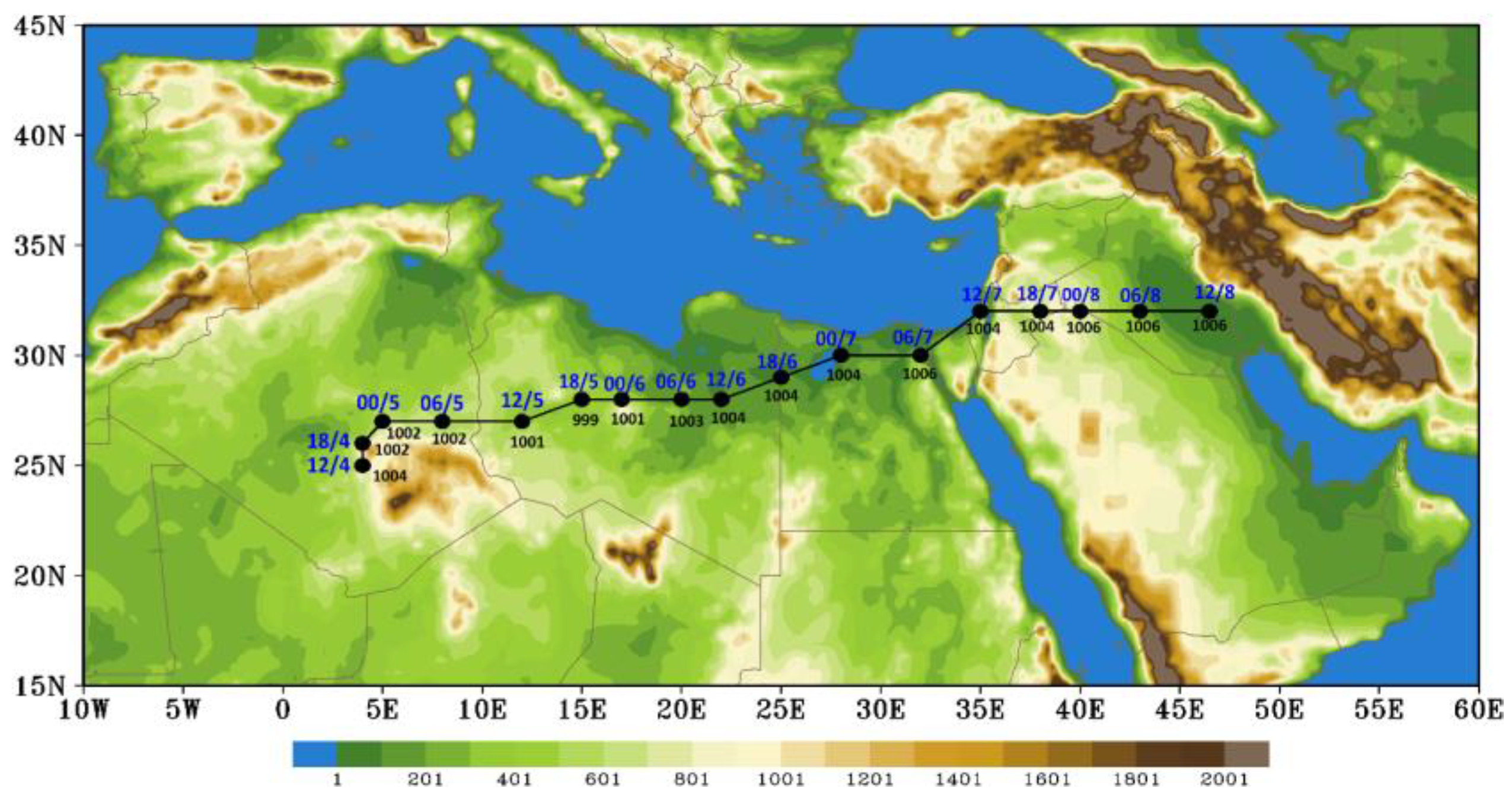
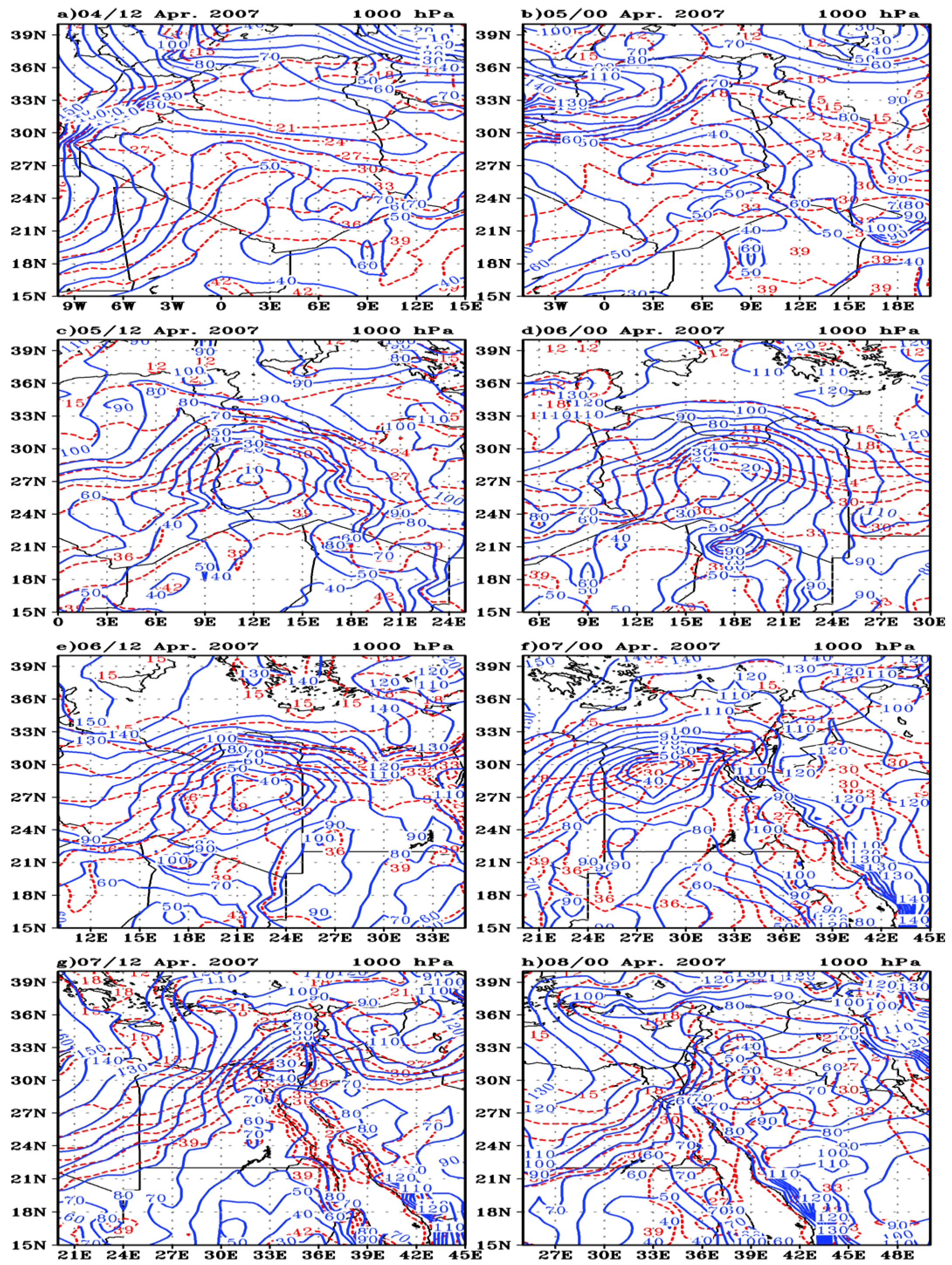


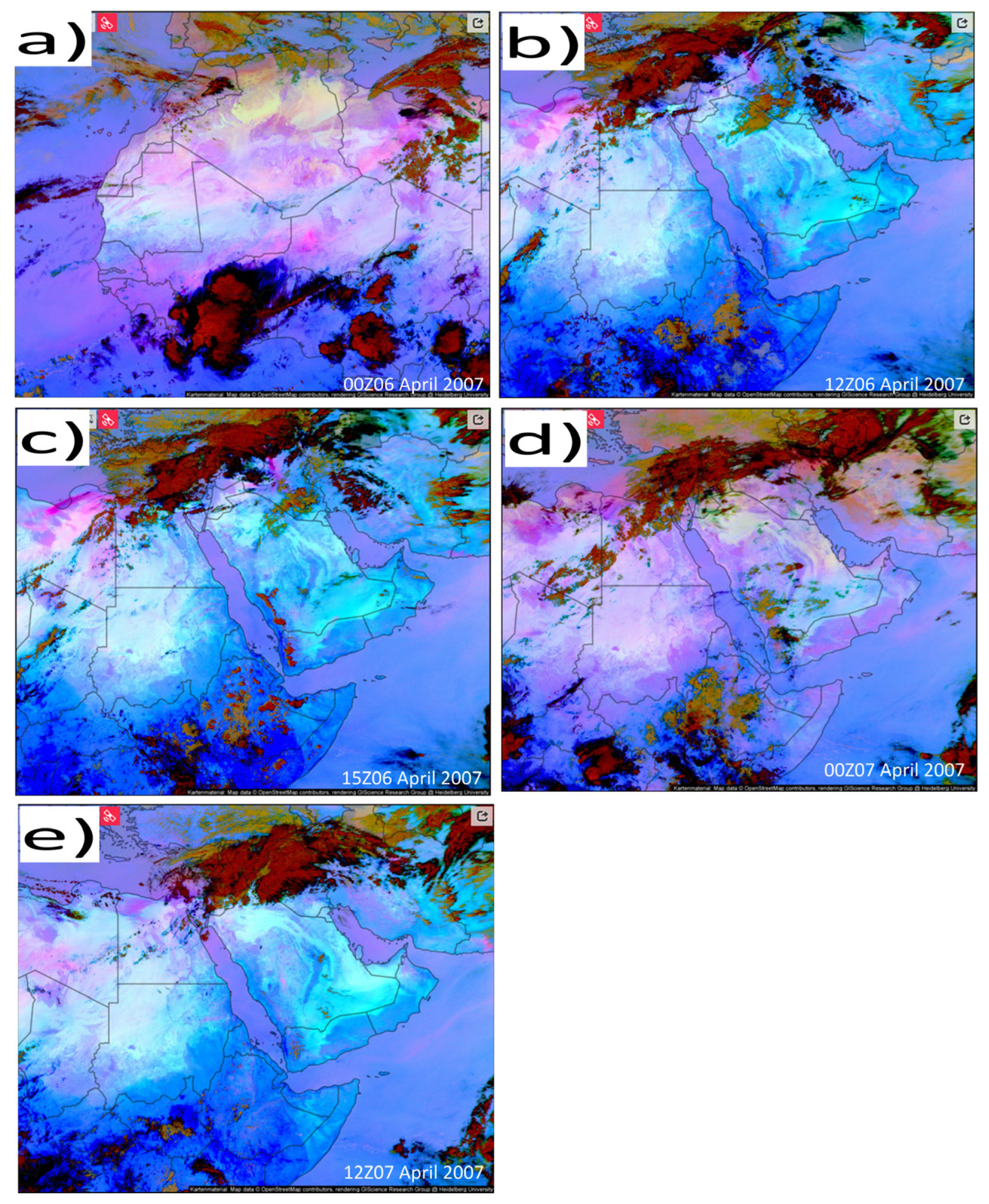
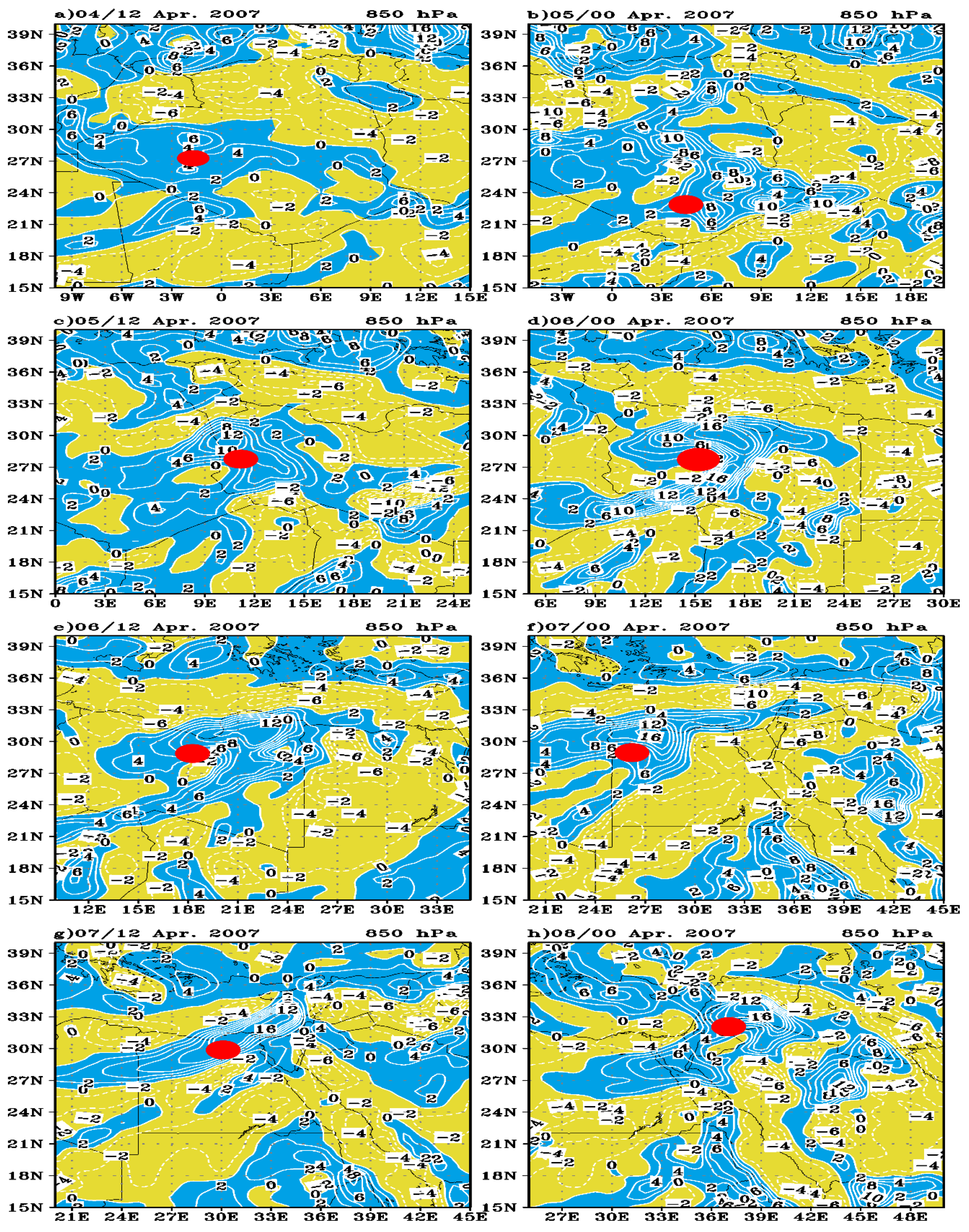

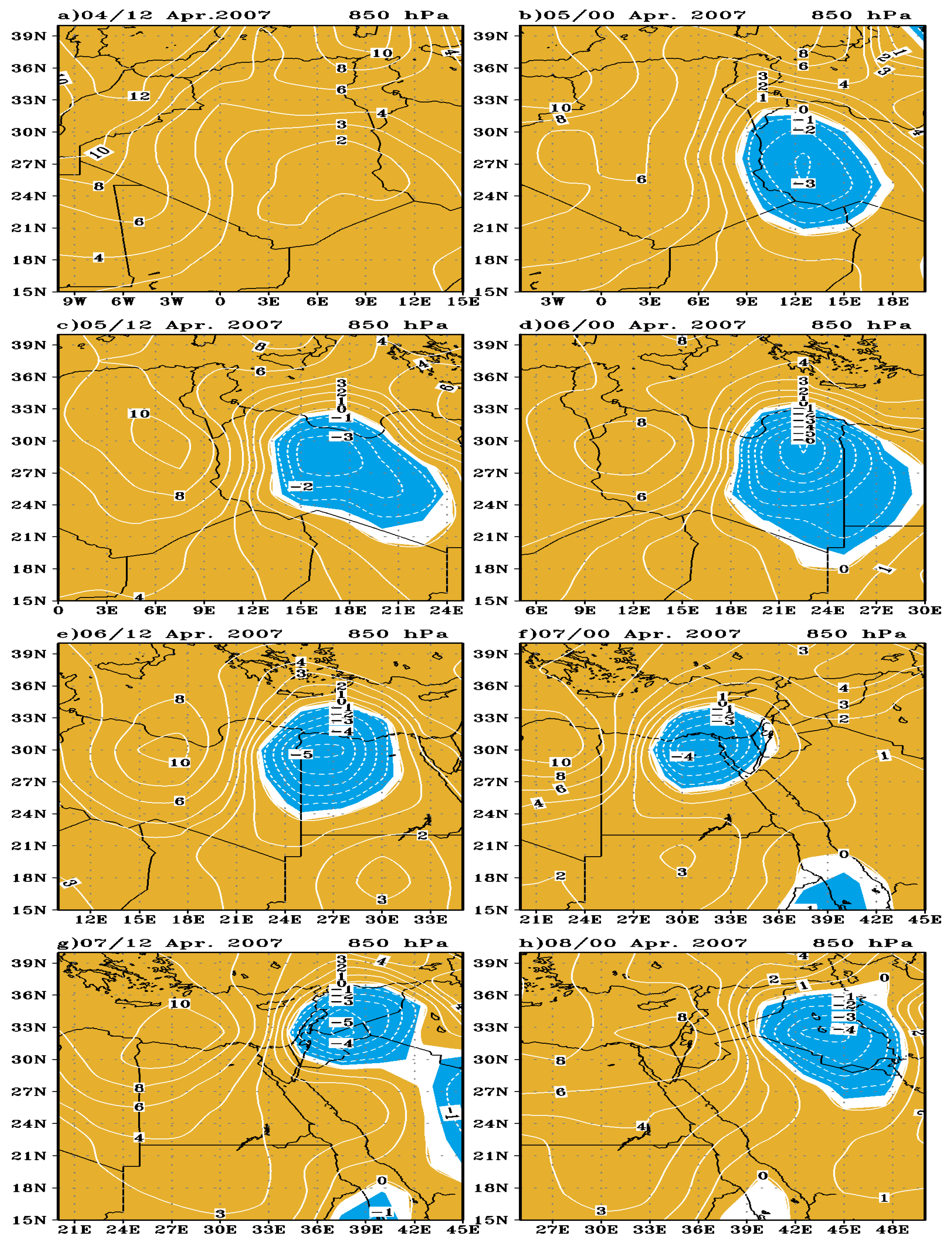

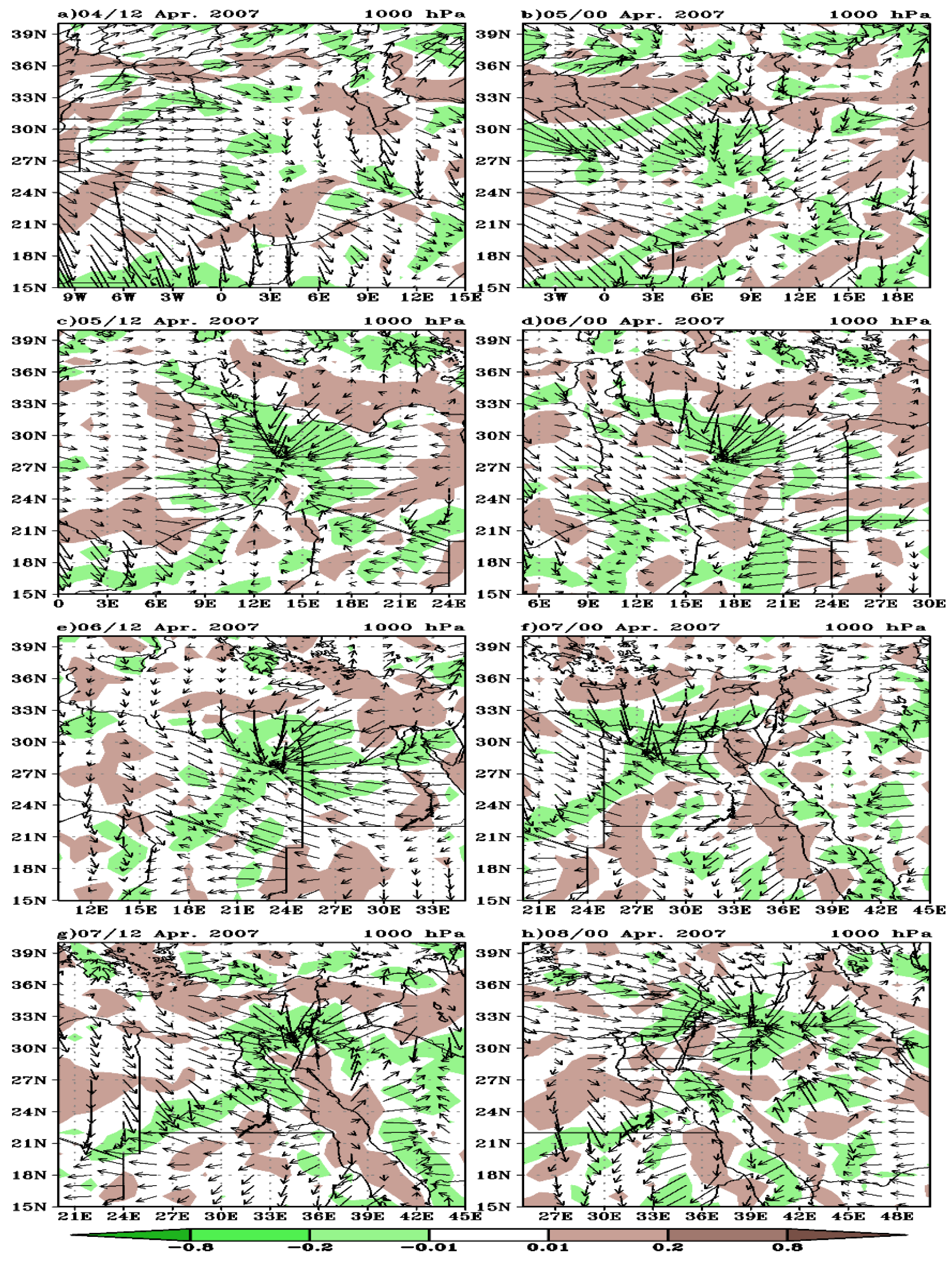
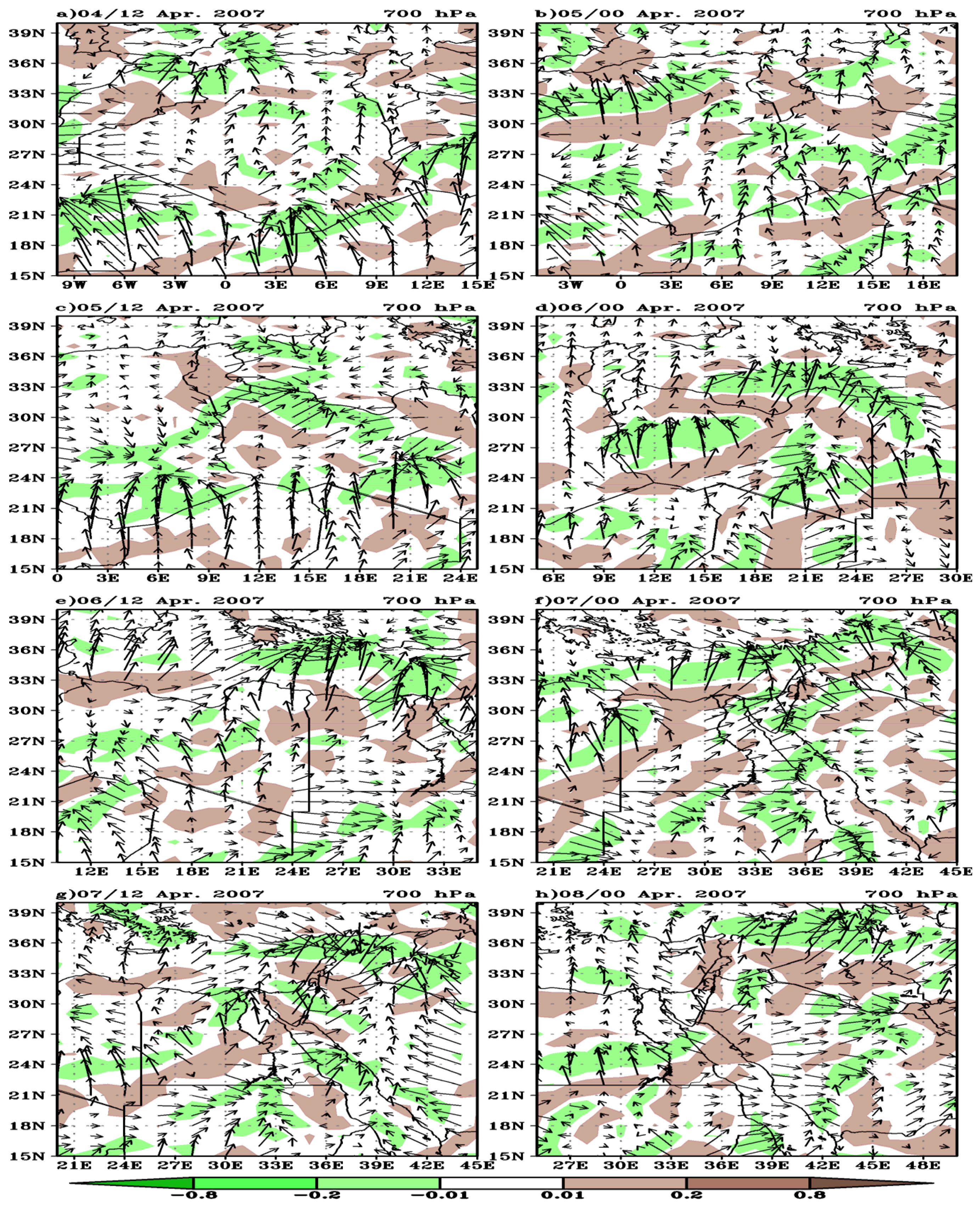
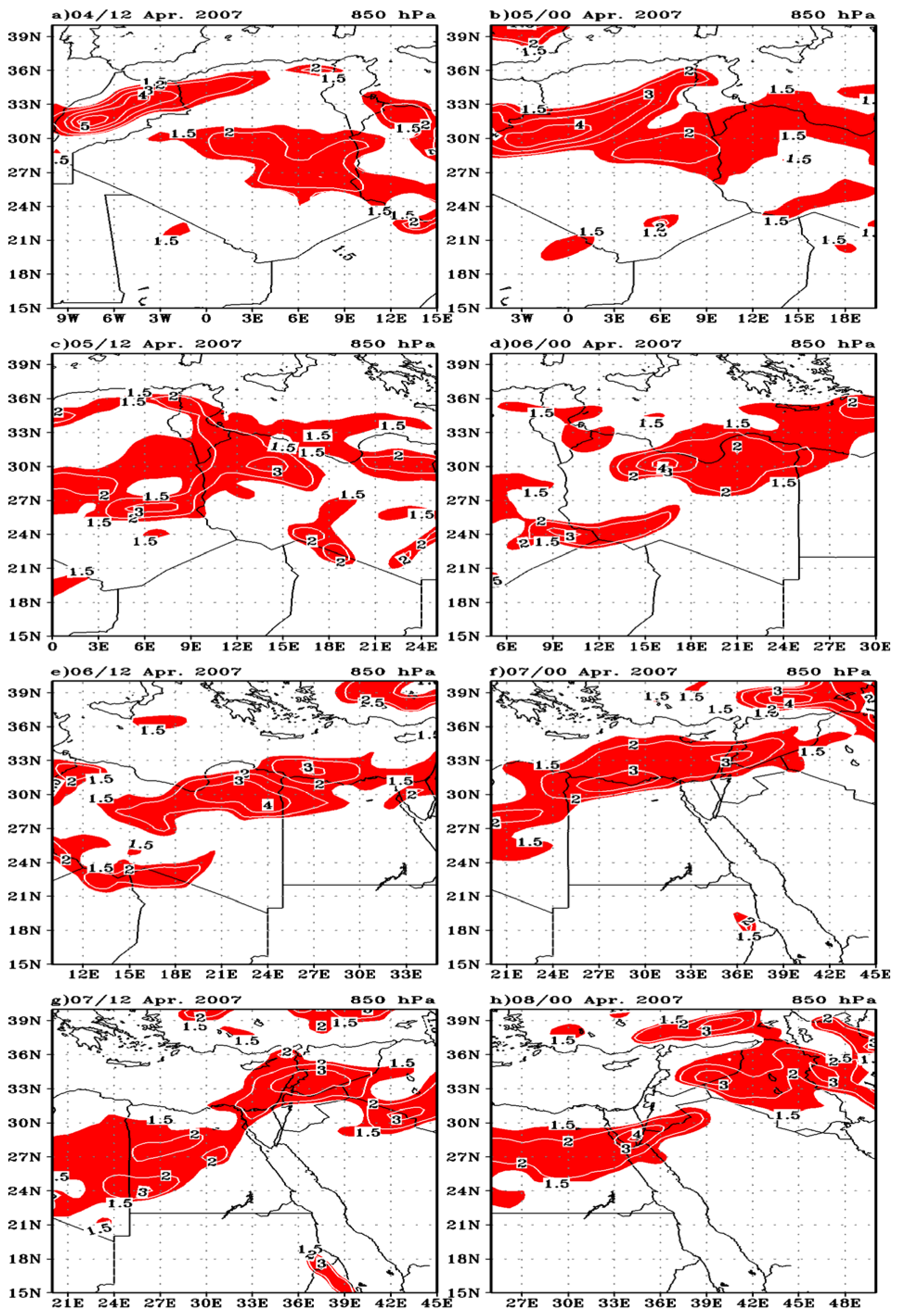
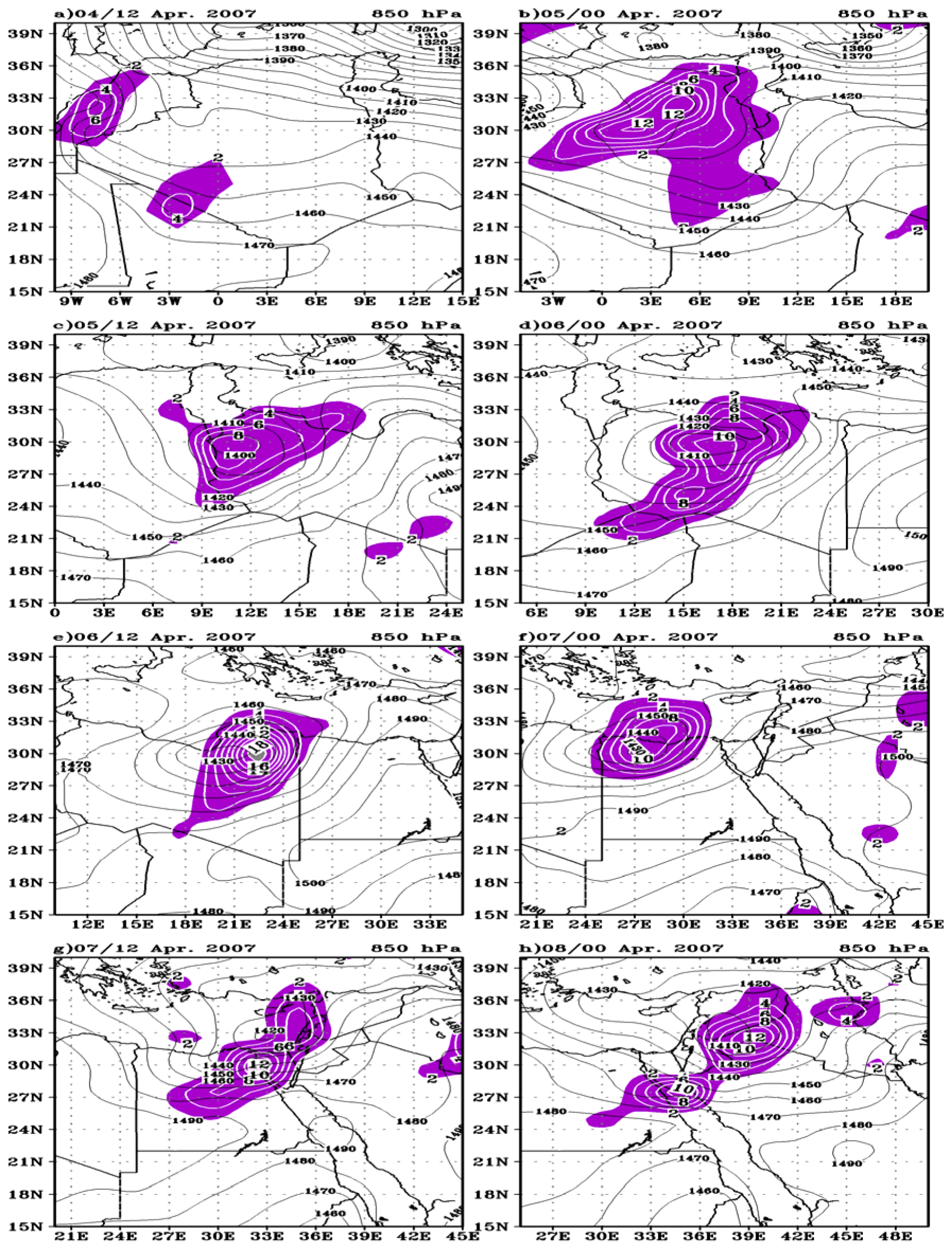


Disclaimer/Publisher’s Note: The statements, opinions and data contained in all publications are solely those of the individual author(s) and contributor(s) and not of MDPI and/or the editor(s). MDPI and/or the editor(s) disclaim responsibility for any injury to people or property resulting from any ideas, methods, instructions or products referred to in the content. |
© 2023 by the authors. Licensee MDPI, Basel, Switzerland. This article is an open access article distributed under the terms and conditions of the Creative Commons Attribution (CC BY) license (https://creativecommons.org/licenses/by/4.0/).
Share and Cite
Al-Mutairi, M.; Labban, A.; Abdeldym, A.; Alkhouly, A.; Abdel Basset, H.; Morsy, M. Diagnostic Study of a Severe Dust Storm over North Africa and the Arabian Peninsula. Atmosphere 2023, 14, 196. https://doi.org/10.3390/atmos14020196
Al-Mutairi M, Labban A, Abdeldym A, Alkhouly A, Abdel Basset H, Morsy M. Diagnostic Study of a Severe Dust Storm over North Africa and the Arabian Peninsula. Atmosphere. 2023; 14(2):196. https://doi.org/10.3390/atmos14020196
Chicago/Turabian StyleAl-Mutairi, Motirh, Abdulhaleem Labban, Abdallah Abdeldym, Ahmed Alkhouly, Heshmat Abdel Basset, and Mostafa Morsy. 2023. "Diagnostic Study of a Severe Dust Storm over North Africa and the Arabian Peninsula" Atmosphere 14, no. 2: 196. https://doi.org/10.3390/atmos14020196
APA StyleAl-Mutairi, M., Labban, A., Abdeldym, A., Alkhouly, A., Abdel Basset, H., & Morsy, M. (2023). Diagnostic Study of a Severe Dust Storm over North Africa and the Arabian Peninsula. Atmosphere, 14(2), 196. https://doi.org/10.3390/atmos14020196





